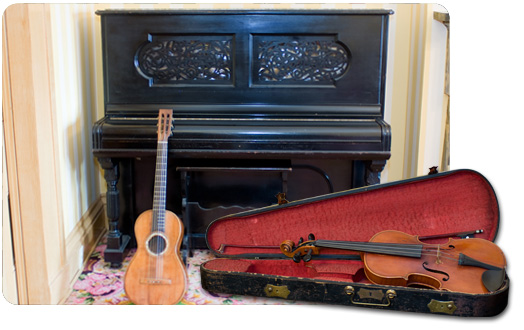
America, Steinway
Eugene Field House Museum
Descriptive Detail
Lying in a case on top of the ebonized, upright-style Steinway piano in Field House’s front parlor is a violin, similar to one that was owned and played by Roswell Field. Leaning against the piano is Eugene Field’s Spanish guitar, its sound hole decorated with mother of pearl.
Local Historical Connections
The piano, the violin, and the guitar are tangible reminders of the musical evenings that were an important part of family life in the nineteenth century. Imagine walking near the Field home and hearing Roswell Field playing his violin. He was known to sit on the front steps and serenade the neighborhood. His son Eugene Field played both the piano and the guitar. Music is integral to and informs many aspects of American social and cultural identity. Until the Industrial Revolution, the gap between the aristocratic upper class and the rural lower class was firmly fixed. The upper class had their harpsichords and private concerts en salon; the lower class had the fiddle in the evenings and the fife and drum in times of war. But as the Industrial Revolution progressed in the nineteenth century, an educated middle class arose with the money and cultural aspirations to invest in a new form of domestic art: the family musical instrument. Since there were no means to reproduce music automatically, people played. Thousands of people played musical instruments at home for pleasure. Most cities, towns, and villages had a glee club, village band, music society, or choir. Music groups sprang up everywhere, often forming the basis for the development of a symphony orchestra, as was the case in St. Louis.
National Historical Connections
The violin, the guitar, and the piano, along with the viola and the cello, were popular nineteenth-century musical instruments that provided home entertainment. Of the five, the violin, the guitar, and the piano were the most popular. Because the violin is small and therefore more portable, it was the instrument of choice for many ethnic communities throughout the world. It also traveled easily, making it a popular instrument for immigrants. The violin is capable of being played quite loudly, which makes it a good dance music instrument, particularly before electric amplification became possible. The guitar, like the violin, is also portable. It first came to the Americas with some of the earliest Spanish explorers, soldiers, and missionaries. There were guitarists among the early French explorers and settlers in America as well. Not as portable as either the violin or guitar, the piano’s popularity lies in its place as a major status symbol and the fact that it represents, in musical terms, the whole orchestra. But most of all, the piano’s popularity rests on the fact that it is by definition a social instrument, and thus it became a natural focus for conviviality among friends and family, instruction between master and pupil, performance with a sibling, or flirtation between young adults.
The central role that these instruments played in everyday life continued into the early twentieth century until the phonograph/gramophone began to dominate home entertainment. The new machine provided music that was ready-made—all that was needed was electricity. By the 1950s the players of instruments had become the consumers of recordings. Today the many varieties of MP3 players represent the next level of personal entertainment in our society.
top^
next artifact}
|

|




